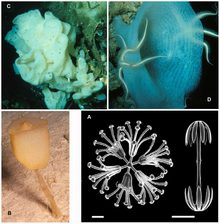Hexasterophora
| Hexasterophora Temporal range: | |
|---|---|

| |
| Scientific classification | |
| Domain: | Eukaryota |
| Kingdom: | Animalia |
| Phylum: | Porifera |
| Class: | Hexactinellida |
| Subclass: | Hexasterophora Schulze, 1886 |
| Subgroups | |
| |
| Synonyms | |

Hexasterophora are a subclass of glass sponges in the class Hexactinellida. Most living hexasterophorans can be divided into three orders: Lyssacinosida, Lychniscosida, and Sceptrulophora.[4] Like other glass sponges, hexasterophorans have skeletons composed of overlapping six-rayed spicules. In addition, they can be characterized by the presence of hexasters, a type of microsclere (microscopic spicules) with six rays unfurling into multi-branched structures.[5][6]
A living sponge is commonly firmly attached by its base to a hard substratum; less often rooted by the anchoring spicules and rarely inserted directly into the loose bottom sediments.
The three orders are differentiated by the extent to which adjacent spicules have fused. The oldest order, without fused spicules, is Lyssacinosida (or Lyssacinosa), which appears in the Ordovician.[1] The other two orders have fully fused their spicules into a framework of dictyonal strands. The most fused order is Lychniscosida (or Lychniscosa), which develops octahedral frames (lychniscs) around the nodes between their dictyonal strands. Lychniscosa fossils first appeared in the Middle Jurassic.[6][7][8]
Sponges intermediate between these two extremes were historically placed into the order Hexactinosa (or Hexactinosida).[6] Genetic sequencing has determined that this proposed order is polyphyletic, with its constituents split between the valid order Sceptrulophora (bearing sceptrules) and the family Dactylocalycidae (lacking sceptrules).[4] The oldest "hexactinosan" fossils are from the Devonian.[6]
References
- ^ a b Botting, J. P.; Janussen, D.; Muir, L. A.; Dohrmann, M.; Ma, J.; Zhang, Y. (March 2022). "Extraordinarily early Venus' flower basket sponges (Hexactinellida, Euplectellidae) from the uppermost Ordovician Anji Biota, China". Palaeontology. 65 (2). doi:10.1111/PALA.12592. ISSN 0031-0239. Wikidata Q111529763.
- ^ "WoRMS - World Register of Marine Species - Aulocalycoida". www.marinespecies.org. Retrieved 11 June 2021.
- ^ "WoRMS - World Register of Marine Species - Hexactinosida". www.marinespecies.org. Retrieved 11 June 2021.
- ^ a b Dohrmann, Martin; Janussen, Dorte; Reitner, Joachim; Collins, Allen G.; Wörheide, Gert (2008). Anderson, Frank (ed.). "Phylogeny and Evolution of Glass Sponges (Porifera, Hexactinellida)". Systematic Biology. 57 (3): 388–405. doi:10.1080/10635150802161088. ISSN 1076-836X.
- ^ Łukowiak, Magdalena; Van Soest, Rob; Klautau, Michelle; Pérez, Thierry; Pisera, Andrzej; Tabachnick, Konstantin (2022). "The terminology of sponge spicules". Journal of Morphology. 283 (12): 1517–1545. doi:10.1002/jmor.21520. ISSN 0362-2525.
- ^ a b c d Treatise on Invertebrate Paleontology Part E, Revised. Porifera, Volume 3: Classes Demospongea, Hexactinellida, Heteractinida & Calcarea, xxxi + 872 p., 506 fig., 1 table, 2004, available here. ISBN 0-8137-3131-3.
- ^ Pisera, A (2006-02-01). "Palaeontology of sponges — a review". Canadian Journal of Zoology. 84 (2): 242–261. doi:10.1139/z05-169. ISSN 0008-4301.
- ^ Krautter, Manfred (2002), Hooper, John N. A.; Van Soest, Rob W. M.; Willenz, Philippe (eds.), "Fossil Hexactinellida: An Overview", Systema Porifera, Boston, MA: Springer US, pp. 1211–1223, doi:10.1007/978-1-4615-0747-5_124, ISBN 978-0-306-47260-2, retrieved 2023-05-02
